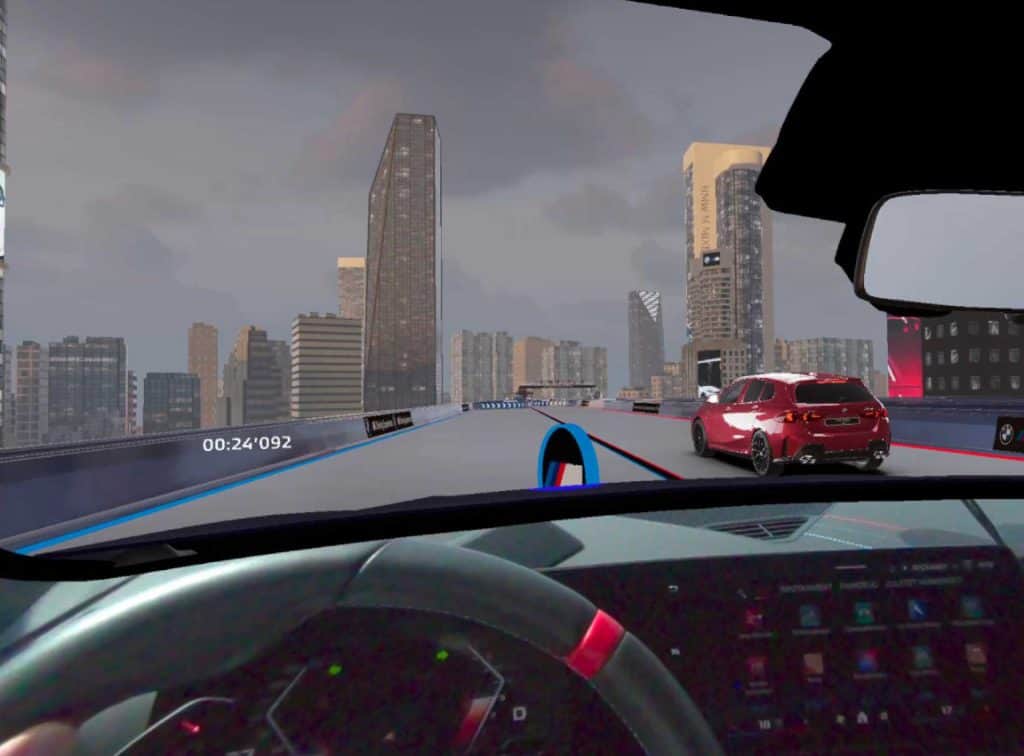
“Mixed reality” refers to the fusion of of physical and digital worlds into a seamless experience. BMW M first presented mixed reality technology at the Web Summit in Lisbon in November 2022 and has been continuously developing it ever since.
With BMW M Mixed Reality, fans and first movers can immerse themselves in a digital world while physically sitting at the wheel of a BMW M vehicle and controlling it.
First-ever multisensory multiplayer
The possibilities of virtual reality are boundless: On a secret mission, you enter the BMW M Garage and from there, you ascend to the top of the BMW M Rooftop Circuit. Surrounded by skyscrapers, two BMW M Mixed Reality customers now race against each other virtually in a multiplayer mode A new feature is that spectators with personified avatars can virtually watch the race live from the BMW M Mixed Reality Bridge. They do not have to be physically present in the area where the multiplayers are driving. They can be virtually connected using devices like the Meta Quest or Apple Vision Pro.
BMW M Mixed Reality will be presented again in Lisbon this year. For BMW M fans, BMW M Mixed Reality has been available in the singleplayer mode since autumn 2023 as part of the BMW M Driving Experience in Maisach, the world’s first driving experience for customers.
For BMW M fans, BMW M Mixed Reality has been available in the singleplayer mode since fall 2023 as part of the BMW M Driving Experience in Maisach, the world’s first driving experience for customers. The pilot project began this year at the BMW M Performance Driving School in California, USA.
Merging reality and the virtual world
The new BMW M Mixed Reality Rooftop Circuit was also a highlight at the presentation of BMW M Mixed Reality. Drivers had to evade virtual obstacles and collect BMW M coins in a shimmering metropolis. The BMW M135 vehicles were used, which thanks to technical refinements can be used as M Mixed Reality vehicles.
This includes very precise GPS positioning on the road surface in order to transfer position and movement to the virtual world. Every acceleration, every turn and every braking manoeuvre is transmitted to the virtual world without latency thanks to precise sensor technology and signal processing. Not only the movements of the vehicle are transmitted, but also those of the driver.
The technology for this is already integrated into the standardised in-vehicle systems of all BMW and BMW M automobiles. These systems are so precise that no additional sensors are required.
Another key element is the VR headset that the driver wears to experience the digital world. This headset must be connected to the vehicle’s internal systems in order to synchronise movements and data in real time. Thanks to this equipment, various BMW M models can be used for BMW M Mixed Reality, regardless of the drive system. This includes vehicles with a conventional combustion engine such as the BMW M2 or BMW M4 as well as models with a fully electric powertrain such as the BMW i5 M60. In the future, BMW M can also imagine offering the new BMW M5 with M Mixed Reality. The technology is flexible and can be adapted to different vehicle platforms to provide a consistent and immersive mixed reality experience.
Digital innovations for the driving experience
BMW Group Mixed Reality is an answer to what future virtual experiences in the automotive sector could look like. At the current stage of development, it enables perfect controllability in every driving situation. Drifting will also be possible in the future, although no date has yet been set for when customers will be able to have this experience.
MINI also benefits from the BMW Group Mixed Reality umbrella: There are also plans to offer customers a multi-sensory mixed reality driving experience.
In addition, further applications in the field of vehicle development and professional training are already being investigated. For example, there is potential as a valuable addition to existing simulator driving in the dynamic driving area, without compromising driving safety, or in the development of driver assistance systems. On existing racetracks, a Professional Track Trainer could in the future display content such as the ideal line and braking points to drivers in order to train them to drive even more precisely. Current AR headset technology is not yet accurate enough for this ambitious use case.